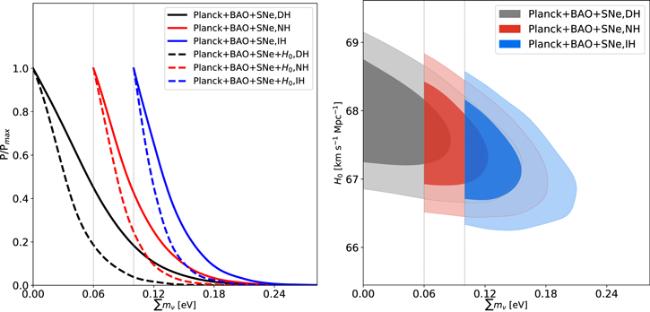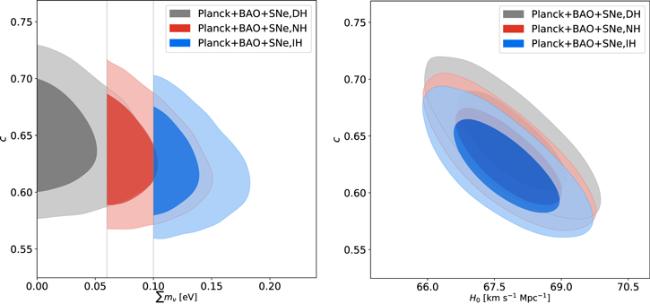1. Introduction
2. Methodology
| • | The ΛCDM+$\sum {m}_{\nu }$ model: The model containing a cosmological constant Λ and cold dark matter is called the ΛCDM model, which can fit various cosmological observations well. For the ΛCDM+$\sum {m}_{\nu }$ model, the parameter space vector is: $\begin{eqnarray}{P}_{1}\equiv \left({\omega }_{b},{\omega }_{c},{{\rm{\Theta }}}_{{\rm{s}}},\tau ,{n}_{{\rm{s}}},\mathrm{ln}[{10}^{10}{A}_{{\rm{s}}}],\sum {m}_{\nu }\right),\end{eqnarray}$ where ${\omega }_{b}\equiv {{\rm{\Omega }}}_{b}{h}^{2}$ and ${\omega }_{c}\equiv {{\rm{\Omega }}}_{c}{h}^{2}$ represent baryon and cold dark matter densities, respectively, Θs is the ratio between sound horizon rs and angular diameter distance DA at the time of photon decoupling, τ is the optical depth to the reionization of the universe, ns and As are the power-law spectral index and amplitude of the power spectrum of primordial curvature perturbations, respectively, and $\sum {m}_{\nu }$ is the total neutrino mass. |
| • | The wCDM+$\sum {m}_{\nu }$ model: The wCDM model is the simplest dynamical dark energy model, in which the equation-of-state (EoS) parameter w(z) is assumed to be a constant. For the wCDM+$\sum {m}_{\nu }$ model, the parameter space vector is: $\begin{eqnarray}{P}_{2}\equiv \left({\omega }_{b},{\omega }_{c},{{\rm{\Theta }}}_{{\rm{s}}},\tau ,{n}_{{\rm{s}}},\mathrm{ln}[{10}^{10}{A}_{{\rm{s}}}],{\text{}}w,\sum {m}_{\nu }\right).\end{eqnarray}$ |
| • | The CPL+$\sum {m}_{\nu }$ model: For probing the evolution of w(z), the most widely used parameterization model is the CPL model [13, 14]. The form of w(z) in this model is given by $\begin{eqnarray}w(z)={w}_{0}+{w}_{a}(1-a)={w}_{0}+{w}_{a}\displaystyle \frac{z}{1+z},\end{eqnarray}$ where w0 and wa are free parameters. So, for the CPL+$\sum {m}_{\nu }$ model, the parameter space vector is: $\begin{eqnarray}{P}_{3}\equiv \left({\omega }_{b},{\omega }_{c},{{\rm{\Theta }}}_{{\rm{s}}},\tau ,{n}_{{\rm{s}}},\mathrm{ln}[{10}^{10}{A}_{{\rm{s}}}],{\text{}}{w}_{0},{\text{}}{w}_{{\text{}}a},\sum {m}_{\nu }\right).\end{eqnarray}$ |
| • | The HDE+$\sum {m}_{\nu }$ model: The HDE model is built based on the the effective quantum field theory together with the holographic principle of quantum gravity. We can put an energy bound on the vacuum energy density, ${\rho }_{\mathrm{de}}{L}^{3}\leqslant {M}_{\mathrm{Pl}}^{2}L$, where MPl is the reduced Planck mass, which means that the total energy in a spatial region with size L should not exceed the mass of a black hole with the same size [71]. The largest length size that is compatible with this bound is the infrared cutoff size of this effective quantum field theory. An infrared scale can saturate that bound, and thus the dark energy density can be written as [15] $\begin{eqnarray}{\rho }_{\mathrm{de}}=3{c}^{2}{M}_{\mathrm{Pl}}^{2}{L}^{-2},\end{eqnarray}$ where c is a dimensionless phenomenological parameter (note that here c is not the speed of light), which plays an important role in determining the properties of the HDE. The value of c determines the evolution of w. In the HDE model, the EoS can be expressed as $\begin{eqnarray}w=-\displaystyle \frac{1}{3}-\displaystyle \frac{2}{3}\displaystyle \frac{\sqrt{{{\rm{\Omega }}}_{\mathrm{de}}}}{c}.\end{eqnarray}$ According to this equation, we can find that in the early times $w\to -1/3$ (since ${{\rm{\Omega }}}_{\mathrm{de}}\to 0$) and in the far future $w\to -1/3-2/(3c)$ (since ${{\rm{\Omega }}}_{\mathrm{de}}\to 1$). Thus, when c < 1, we can find that the EoS parameter w crosses −1 during the cosmological evolution. For the HDE+$\sum {m}_{\nu }$ model, the parameter space vector is: $\begin{eqnarray}{P}_{4}\equiv \left({\omega }_{b},{\omega }_{c},{{\rm{\Theta }}}_{{\rm{s}}},\tau ,{n}_{{\rm{s}}},\mathrm{ln}[{10}^{10}{A}_{{\rm{s}}}],{\text{}}c,\sum {m}_{\nu }\right).\end{eqnarray}$ |
| • | The CMB data: We employ the CMB likelihood including the TT, TE, and EE spectra at ℓ ≥ 30, the low-ℓ temperature Commander likelihood, and the low-ℓ SimAll EE likelihood, from the Planck 2018 release [12]. |
| • | The BAO data: We employ the measurements of the BAO signals from different galaxy surveys, including the DR7 Main Galaxy Sample at the effective redshift of zeff = 0.15 [72], the six-degree-field Galaxy Survey (6dFGS) at zeff = 0.106 [73], and the latest BOSS data release 12 (DR12) in three redshift slices of zeff = 0.38, 0.51, and 0.61 [74]. |
| • | The SNe data: We use the latest SNe data given the Pantheon Sample [75], which contains 1048 SNe data in the redshift range of 0.01 < z < 2.3. |
| • | The Hubble constant: We use the result of the direct measurement of the Hubble constant, with the result of H0 = 74.03 ± 1.42 km s−1 Mpc−1, given by Riess et al [68]. |
Figure 1. Left: the one-dimensional marginalized posterior distributions for $\sum {m}_{\nu }$ using the Planck+BAO+SNe and Planck+BAO+SNe+H0 data combinations in the ΛCDM+$\sum {m}_{\nu }$ model. Right: the two-dimensional marginalized contours (1σ and 2σ) in the $\sum {m}_{\nu }$-H0 plane for three neutrino mass hierarchy cases, i.e. the DH case, the NH case, and the IH case, by using Planck+BAO+SNe data combination in the ΛCDM+$\sum {m}_{\nu }$ model. |
3. Results and discussion
Figure 2. The two-dimensional marginalized contours (1σ and 2σ) in the $\sum {m}_{\nu }$-w and H0-w planes for three neutrino mass hierarchy cases, i.e. the DH case, the NH case, and the IH case, by using Planck+BAO+SNe data combination in the wCDM+$\sum {m}_{\nu }$ model. |
Table 1. Fitting results of the cosmological parameters in the ΛCDM+$\sum {m}_{\nu }$ model for three neutrino mass hierarchy cases, i.e. the DH case, the NH case, and the IH case, using the Planck+BAO+SNe and Planck+BAO+SNe+H0 data combinations. |
| Data | Planck+BAO+SNe | Planck+BAO+SNe+H0 | ||||
|---|---|---|---|---|---|---|
| Mass ordering | DH | NH | IH | DH | NH | IH |
| H0 (km s−1 Mpc−1) | 67.75 ± 0.49 | 67.48 ± 0.47 | 67.26 ± 0.45 | 68.40 ± 0.44 | 68.11 ± 0.43 | 67.88 ± 0.43 |
| Ωm | 0.3097 ± 0.0063 | 0.3126 ± 0.0063 | 0.3150 ± 0.0060 | 0.3015 ± 0.0056 | 0.3044 ± 0.0056 | 0.3069 ± 0.0056 |
| σ8 | ${0.812}_{-0.008}^{+0.013}$ | ${0.801}_{-0.008}^{+0.011}$ | ${0.793}_{-0.008}^{+0.010}$ | ${0.813}_{-0.008}^{+0.010}$ | ${0.801}_{-0.008}^{+0.009}$ | ${0.792}_{-0.008}^{+0.009}$ |
| $\sum {m}_{\nu }$ (eV) | $\lt 0.123$ | <0.156 | <0.185 | <0.082 | <0.125 | <0.160 |
| | ||||||
| χ2 | 3805.133 | 3807.205 | 3809.012 | 3821.466 | 3825.557 | 3828.810 |
3.1. Cases in different dark energy models
Figure 3. The two-dimensional marginalized contours (1σ and 2σ) in the w0-wa plane for three neutrino mass hierarchy cases, i.e. the DH case, the NH case, and the IH case, by using Planck+BAO+SNe and Planck+BAO+SNe+H0 data combinations in the CPL+$\sum {m}_{\nu }$ model. |
Table 2. Fitting results of the cosmological parameters in the wCDM+$\sum {m}_{\nu }$ model for three neutrino mass hierarchy cases, i.e. the DH case, the NH case, and the IH case, using the Planck+BAO+SNe and Planck+BAO+SNe+H0 data combinations. |
| Data | Planck+BAO+SNe | Planck+BAO+SNe+H0 | ||||
|---|---|---|---|---|---|---|
| Mass ordering | DH | NH | IH | DH | NH | IH |
| w | −1.029 ± 0.035 | −1.042 ± 0.035 | −1.051 ± 0.035 | −1.078 ± 0.033 | −1.090 ± 0.033 | $-{1.100}_{-0.031}^{+0.034}$ |
| H0 (km s−1 Mpc−1) | 68.27 ± 0.83 | 68.23 ± 0.83 | 68.21 ± 0.81 | 69.79 ± 0.73 | 69.74 ± 0.73 | 69.70 ± 0.74 |
| Ωm | 0.3064 ± 0.0078 | 0.3076 ± 0.0078 | 0.3084 ± 0.0076 | 0.2932 ± 0.0066 | 0.2945 ± 0.0066 | 0.2954 ± 0.0067 |
| σ8 | 0.819 ± 0.015 | ${0.811}_{-0.014}^{+0.015}$ | 0.805 ± 0.014 | ${0.834}_{-0.013}^{+0.015}$ | ${0.826}_{-0.013}^{+0.014}$ | 0.820 ± 0.014 |
| $\sum {m}_{\nu }$ (eV) | <0.155 | <0.195 | <0.220 | <0.145 | <0.183 | <0.210 |
| | ||||||
| χ2 | 3805.053 | 3806.381 | 3807.724 | 3817.072 | 3818.757 | 3819.912 |
Table 3. Fitting results of the cosmological parameters in the CPL+$\sum {m}_{\nu }$ model for three neutrino mass hierarchy cases, i.e. the DH case, the NH case, and the IH case, using the Planck+BAO+SNe and Planck+BAO+SNe+H0 data combinations. |
| Data | Planck+BAO+SNe | Planck+BAO+SNe+H0 | ||||
|---|---|---|---|---|---|---|
| Mass ordering | DH | NH | IH | DH | NH | IH |
| w0 | −0.945 ± 0.087 | −0.933 ± 0.089 | −0.923 ± 0.089 | −1.003 ± 0.082 | −0.988 ± 0.086 | −0.978 ± 0.088 |
| wa | $-{0.41}_{-0.30}^{+0.44}$ | $-{0.52}_{-0.32}^{+0.46}$ | $-{0.61}_{-0.33}^{+0.46}$ | $-{0.38}_{-0.31}^{+0.41}$ | $-{0.50}_{-0.33}^{+0.44}$ | $-{0.60}_{-0.34}^{+0.45}$ |
| H0 (km s−1 Mpc−1) | 68.22 ± 0.83 | 68.19 ± 0.83 | 68.14 ± 0.84 | 69.78 ± 0.73 | 69.71 ± 0.74 | 69.69 ± 0.73 |
| Ωm | 0.3087 ± 0.0082 | 0.3102 ± 0.0083 | 0.3113 ± 0.0083 | 0.2948 ± 0.0068 | 0.2965 ± 0.0070 | 0.2976 ± 0.0069 |
| σ8 | ${0.819}_{-0.015}^{+0.018}$ | ${0.813}_{-0.015}^{+0.018}$ | ${0.808}_{-0.015}^{+0.018}$ | ${0.835}_{-0.015}^{+0.017}$ | ${0.828}_{-0.014}^{+0.017}$ | ${0.823}_{-0.014}^{+0.017}$ |
| $\sum {m}_{\nu }$ (eV) | <0.247 | <0.290 | <0.305 | <0.216 | <0.255 | <0.281 |
| | ||||||
| χ2 | 3804.644 | 3805.938 | 3806.531 | 3816.716 | 3817.806 | 3818.809 |
Table 4. Fitting results of the cosmological parameters in the HDE+$\sum {m}_{\nu }$ model for three neutrino mass hierarchy cases, i.e. the DH case, the NH case, and the IH case, using the Planck+BAO+SNe and Planck+BAO+SNe+H0 data combinations. |
| Data | Planck+BAO+SNe | Planck+BAO+SNe+H0 | ||||
|---|---|---|---|---|---|---|
| Mass ordering | DH | NH | IH | DH | NH | IH |
| c | ${0.645}_{-0.031}^{+0.027}$ | ${0.632}_{-0.030}^{+0.026}$ | ${0.623}_{-0.029}^{+0.025}$ | ${0.608}_{-0.025}^{+0.023}$ | 0.595 ± 0.024 | ${0.587}_{-0.024}^{+0.022}$ |
| H0 (km s−1 Mpc−1) | 67.85 ± 0.81 | 67.79 ± 0.79 | 67.74 ± 0.80 | 69.38 ± 0.72 | 69.33 ± 0.71 | 69.27 ± 0.71 |
| Ωm | 0.3061 ± 0.0077 | 0.3077 ± 0.0076 | 0.3087 ± 0.0076 | 0.2927 ± 0.0065 | 0.2939 ± 0.0065 | 0.2951 ± 0.0065 |
| σ8 | 0.797 ± 0.013 | 0.789 ± 0.013 | 0.783 ± 0.013 | 0.811 ± 0.013 | 0.803 ± 0.012 | 0.796 ± 0.12 |
| $\sum {m}_{\nu }$ (eV) | <0.080 | <0.129 | <0.163 | <0.075 | <0.123 | <0.159 |
| | ||||||
| χ2 | 3822.977 | 3828.219 | 3830.980 | 3838.467 | 3845.127 | 3845.289 |
Figure 4. The two-dimensional marginalized contours (1σ and 2σ) in the H0-c and $\sum {m}_{\nu }$-c planes for three neutrino mass hierarchy cases, i.e. the DH case, the NH case, and the IH case, by using Planck+BAO+SNe data combination in the HDE+$\sum {m}_{\nu }$ model. |







